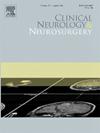Concomitant multiple sclerosis and cervical myelopathy: A propensity-matched QOD analysis of patient-reported outcomes and return to work after cervical spine surgery
IF 1.8
4区 医学
Q3 CLINICAL NEUROLOGY
引用次数: 0
Abstract
Objective
The diagnosis of degenerative cervical myelopathy (CM) in multiple sclerosis (MS) patients is challenging due to overlapping symptomatology and radiological findings. Minimal literature reports patient reported outcomes measures (PROMs) for MS patients undergoing surgery for CM. Given the diagnostic difficulty, we aimed to determine if patients with MS have worse outcomes after elective cervical spine surgery.
Methods
126 patients who underwent surgery for CM were retrospectively obtained from the Quality Outcomes Database (QOD). 63 MS patients were age and gender matched to 63 without MS. Postoperative PROMs including Visual Analogue Scale for neck/arm pain (VAS), Neck Disability Index (NDI), and satisfaction were compared at 3 and 12 months. Postoperative complications and return to work were studied as secondary outcomes.
Results
The average age of both cohorts was 57.9 years, and 63.5 % were female. Baseline functional status and symptomatology were similar, although fewer MS patients could independently ambulate (p = .014). The operative time and length of stay were similar. MS patients had a greater average ASA grade (p = 0.018), however there were no significant differences in VAS, NDI, or satisfaction. MS patients had a higher 3-month readmission rate (p = .044), however returned to work at a similar rate greater than 70 %.
Conclusion
PROMs do not significantly differ for CM patients with concomitant MS. Patients with MS had a higher 3-month complication rate, although readmissions were largely unrelated to the procedure. Thus, despite the diagnostic challenge of CM in MS patients, the surgical outcomes are comparable to those without MS.
伴发多发性硬化症和颈椎病:颈椎手术后患者报告结果和重返工作岗位的倾向匹配QOD分析
目的:多发性硬化症(MS)患者的退行性颈椎病(CM)的诊断是具有挑战性的,因为重叠的症状和影像学表现。很少有文献报道接受CM手术的MS患者报告的结果测量(PROMs)。鉴于诊断困难,我们的目的是确定MS患者在择期颈椎手术后是否有更差的预后。方法:从质量结局数据库(QOD)中回顾性获取126例CM手术患者。63例MS患者的年龄和性别与63例非MS患者相匹配。术后3个月和12个月的PROMs评分包括颈/臂疼痛视觉模拟量表(VAS)、颈部残疾指数(NDI)和满意度进行比较。术后并发症和重返工作作为次要结果进行研究。结果:两组患者的平均年龄为57.9岁,63.5% %为女性。基线功能状态和症状相似,但能够独立行走的MS患者较少(p = .014)。手术时间和住院时间相似。MS患者的平均ASA等级更高(p = 0.018),但VAS、NDI或满意度没有显著差异。MS患者的3个月再入院率较高(p = .044),但恢复工作的比率相似,大于70% %。结论:CM合并MS患者的PROMs无显著差异,MS患者的3个月并发症发生率较高,尽管再入院与手术无关。因此,尽管多发性硬化症患者的CM诊断困难,但手术结果与非多发性硬化症患者相当。
本文章由计算机程序翻译,如有差异,请以英文原文为准。
求助全文
约1分钟内获得全文
求助全文
来源期刊

Clinical Neurology and Neurosurgery
医学-临床神经学
CiteScore
3.70
自引率
5.30%
发文量
358
审稿时长
46 days
期刊介绍:
Clinical Neurology and Neurosurgery is devoted to publishing papers and reports on the clinical aspects of neurology and neurosurgery. It is an international forum for papers of high scientific standard that are of interest to Neurologists and Neurosurgeons world-wide.
 求助内容:
求助内容: 应助结果提醒方式:
应助结果提醒方式:


